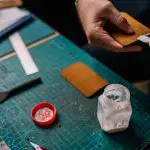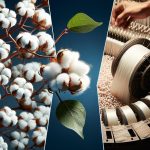Yes, 100% rayon is definitely soft! It's made from natural wood pulp and has a silky smooth texture that feels luxurious against the skin. I've noticed it drapes beautifully and offers that plush, fluid softness that makes it so popular for clothes and other textiles. It's particularly good for sensitive skin because it manages moisture well, keeping you comfortable. Plus, it's kind to your skin, avoiding irritation. If you're looking for comfort and softness in your fabrics, rayon is a top choice. Stick around, and you'll find out just how versatile and beneficial rayon can be for a range of uses.
Table of Contents
Key Takeaways
- Rayon is inherently soft and silky, providing a luxurious feel to the touch.
- Its smooth texture and plush feel make it popular for comfortable clothing.
- The fabric's fluid softness allows it to drape beautifully, enhancing its softness.
- Rayon's effective moisture management contributes to its comfort and soft texture.
- Proper care, like gentle washing and avoiding high heat, helps maintain its softness.
Understanding Rayon Fabric
Although rayon fabric is derived from natural wood pulp, it's the processing that gives it a uniquely soft and silky feel. I've always found that understanding the roots of rayon helps in appreciating its qualities. Originating from wood pulp means that rayon isn't just another synthetic fabric. It's more of a regenerated cellulose fiber, which makes a world of difference when you're talking about texture and comfort.
Rayon fabric is fascinating because it bridges the gap between natural and synthetic materials. The wood pulp undergoes a chemical transformation that allows the resulting fabric to mimic qualities of natural fibers, particularly silk. This process, while complex, is what makes rayon fabric so desirable in the fashion and home textile industries.
When you hear about 100% rayon fabric, you're talking about a material that doesn't blend with other fibers. It maintains the characteristic softness and silk-like feel all on its own. This purity is crucial for achieving the optimal level of softness and comfort that rayon is known for. It's no wonder that clothes and linens made from 100% rayon are so popular—they offer a touch of luxury without compromising on comfort.
The Softness of Rayon
Exploring the softness of rayon reveals why it's such a cherished material in clothing and textiles. Its inherent softness and smooth texture make it a go-to for those of us seeking comfort without sacrificing style. The tactile pleasure of rayon is undeniable; it feels luxurious and silky against the skin, enhancing the wearer's experience with every touch.
The unique properties of 100% rayon contribute extensively to its plush feel. Unlike some synthetic fibers that can feel stiff or plasticky, rayon maintains a fluid softness that drapes beautifully. This quality not only makes it pleasant to wear but also appealing to look at. It's no wonder many people find rayon garments exceptionally comfortable and soft.
Moreover, rayon's texture plays a significant role in its overall appeal. The smoothness of the fabric ensures that it glides over your skin, minimizing any irritation and maximizing comfort. It's this combination of aesthetic appeal and sensory pleasure that makes rayon a popular choice for a variety of clothing items, from flowy dresses to soft shirts. In the realm of textiles, rayon truly stands out for its soft, luxurious feel.
Rayon's Comfort Factor
When we talk about what makes rayon so comfy, we can't ignore its texture.
It's not just soft; it also wicks moisture well, which is a big plus for anyone who hates feeling sweaty.
Plus, if you've got sensitive skin, you'll want to know how rayon stacks up against other fabrics.
Rayon Texture Qualities
Rayon's silky, smooth texture makes it a top pick for comfortable, stylish clothing. Its luxurious feel is akin to silk but without breaking the bank. I've noticed that 100% rayon garments are exceptionally soft, adding a touch of luxury to everyday wear.
This fabric's smoothness is gentle on the skin, which enhances overall comfort. When I choose clothing, the texture plays a huge role, and rayon's silky quality never disappoints. It drapes beautifully too, making it perfect for flowy dresses or shirts.
The comfort and softness of rayon, combined with its luxurious texture, undoubtedly elevate any outfit. It's easy to see why it's so popular for those who value both style and comfort.
Moisture Absorption Ability
I've found that rayon's ability to absorb moisture significantly boosts its comfort level, making it ideal for both hot and cool weather. The natural fibers in 100% rayon contribute to this moisture absorption ability, enhancing the fabric's overall softness.
When I wear rayon, it feels incredibly soft to the touch, and its smooth texture adds to the comfort. This ability to manage moisture, drawing it away from the skin, ensures that I stay dry and comfortable, regardless of the temperature.
It's this combination of softness and effective moisture management that makes rayon a top choice for clothes designed to offer comfort. Rayon really stands out for keeping you comfortable through its soft, absorbent qualities.
Skin Sensitivity Considerations
Considering its smooth texture and silk-like feel, rayon is especially kind to sensitive skin, minimizing irritation and enhancing comfort.
It's not just soft; it's the kind of comfortable that you notice as soon as it touches your skin. For those of us with skin sensitivities, finding clothes that don't cause discomfort can be a challenge, but rayon's gentle nature makes it a reliable choice.
Its breathability further adds to its appeal, ensuring you don't feel smothered or overly sweaty. This fabric manages to combine practicality with luxury, making it ideal for everyday wear while still feeling indulgent.
Comparing Rayon With Other Fabrics
When comparing rayon to other fabrics like cotton, its luxurious softness really stands out. There's a silk-like feel to rayon that makes it not just comfortable but also gives it an elegant drape that's hard to find in more common textiles. It's the kind of fabric you reach for when you want something that looks classy without sacrificing comfort.
Rayon's smooth texture is what elevates it for use in flowing dresses and breezy shirts. It's this unique characteristic that allows it to rival even other variants of rayon like modal and lyocell. Each of these fabrics shares the softness and comfort we all love, but 100% rayon has a certain allure that's hard to beat. Especially in warmer climates, its breathability paired with its softness makes it a top choice for clothing that needs to feel as good as it looks.
Understanding rayon's softness helps appreciate why it's favored for elegant garments. It's not just about looking good; it's also about feeling good in what you're wearing. That's the magic of rayon—it combines style and comfort effortlessly.
Care Instructions for Rayon
To keep the elegance and comfort of 100% rayon intact, proper care is key. Understanding how rayon responds to different cleaning methods is crucial since its production process makes it somewhat delicate. Let's dive into how to maintain its luxurious feel without causing damage.
First things first, rayon should be hand washed or put through a gentle cycle in your washing machine. Hot water's a no-go; it can lead to shrinking and can strip away that lovely softness we all cherish. I always stick to cool or lukewarm water to keep things safe.
When drying, air drying is your best bet to preserve that soft texture. If you're in a pinch and need to use a dryer, make sure it's set on low heat. High heat can be a nightmare for rayon, leading to significant shrinkage and potentially ruining the fabric's handfeel.
Lastly, when it comes to ironing, always iron with low heat. High temperatures can scorch rayon, and that's the last thing you'd want. A gentle press with a warm iron does the trick, keeping everything smooth without damage.
Here's a quick guide to refer to:
| Washing | Drying |
|---|---|
| Hand washed or gentle cycle | Air dried or tumble dry low |
| Cool or lukewarm water | Low heat when using a dryer |
| Avoid hot water | Iron with low heat |
Stick to these tips, and your rayon garments will stay soft and luxurious for years to come!
Durability Concerns
While I love the softness of 100% rayon, I've noticed it's not the toughest fabric out there, especially when it gets wet.
It's crucial to know the best ways to maintain it, because it can easily stretch or tear if you're not careful.
Let's talk about how to handle rayon to keep it looking great without wearing it out too quickly.
Rayon Wear-and-Tear
Rayon's durability takes a hit when it gets wet, making it less sturdy than many other fabrics. When you're dealing with rayon, keep in mind that its strength when wet significantly drops. This means that moisture exposure isn't just bad news; it's practically an invitation for trouble. Over time, this vulnerability can lead to some serious wear-and-tear.
What's more, rayon is notorious for its tendency to shrink. Think about that favorite rayon shirt you might've shrunk after a wash—a real bummer, right? Plus, the fabric shading can alter, giving your clothes a less appealing look and feel due to pile distortion. So, despite its cozy feel, rayon isn't exactly a champion in the durability department.
Maintenance Best Practices
Caring properly for 100% rayon is key to keeping it soft and extending its life despite its durability concerns. You've gotta be gentle, especially when it comes to washing. Tossing it in a regular machine wash with your jeans? Big no-no. Always stick to gentle washing settings, or better yet, hand wash it. This helps maintain that comfortable, silky feel without stressing the fabric too much.
And let's talk drying and ironing. Keep it cool—literally. High heat can be a nightmare for rayon, so low heat drying and ironing are the way to go. Always check the care instructions on the tag. Trust me, a little extra care goes a long way with rayon.
Styling Tips for Rayon Clothing
How can you elevate your rayon outfits with simple styling tips? Let's dive into some straightforward advice to keep your rayon clothing looking chic and feeling comfortable. Rayon, with its soft texture, is a pleasure to style because of its versatility and luxurious feel. Whether you're dressing up for a night out or aiming for a casual day look, these tips are essential.
- Accessorize Wisely: Adding a belt or a scarf can define your waist and enhance the overall appeal of a rayon dress or blouse. Choose accessories that complement the softness without overwhelming it.
- Layer Smartly: Throw on a lightweight jacket or a cozy cardigan over your rayon top. Layering not only adjusts to changing temperatures but also adds a touch of sophistication.
- Pick the Right Fit: Ensure that you choose rayon garments that fit well. Too tight, and they'll lose comfort; too loose, and they may look sloppy.
- Gentle Care: Follow care instructions meticulously. Wash gently and iron on low heat to maintain the fabric's softness and durability.
- Mix Textures: Combine rayon with other textures like denim or leather for a dynamic, interesting look that feels as good as it looks.
Common Uses of Rayon
So, let's talk about where you'll typically find rayon being used.
It's not just in your comfy tees and dresses; rayon's also big in home decor and even in medical textiles.
Whether it's in those chic curtains or breathable surgical gowns, rayon's versatility shines through in different industries.
Rayon in Fashion Design
Rayon's versatility shines in fashion design, where it's favored for creating everything from luxurious dresses to comfortable shirts. This fabric's unique properties make it a staple in the fashion industry. Due to its mimicry of natural fibers like silk and cotton, designers often turn to rayon when they're aiming for that soft, smooth feel without the steep price. It's amazing how it combines comfort with a chic appearance, making it perfect for a variety of clothing items.
- Dresses: Emphasizes fluidity and elegance.
- Blouses: Offers a gentle, caressing touch.
- Casual Shirts: Maintains breathability while staying stylish.
- Evening Wear: Adds a touch of glamour with its silky texture.
- Skirts: Provides a nice drape that enhances body movements.
Home Decor Applications
I've noticed that many stylish homes often use rayon in items like curtains and upholstery because of its softness and luxurious look. This fabric makes any room feel more inviting and elegant.
Beyond draperies, rayon is a top choice for bedding—sheets, pillowcases, and duvet covers all benefit from its comfort and breathability. Mixing rayon with polyester or cotton also helps these home decor pieces resist wrinkles and last longer.
For a splash of color and texture, decorative throw pillows and tablecloths often incorporate rayon. Its vibrant colors and elegant drape make it ideal for these uses. The soft, smooth feel of rayon really shines in luxurious decorative throws and accent pieces, enhancing the overall aesthetic of any space.
Medical Textile Uses
In the medical field, rayon is prized for its use in surgical gowns, bandages, and other textiles that require softness and hypoallergenic properties. It's truly a standout for those who need both comfort and effective care, and here's why:
- Softness and Smooth Texture: Enhances the comfort of patients, particularly in medical apparel and bedding.
- Moisture-Absorbing Properties: Keeps wounds drier and promotes healing, making it ideal for bandages and wound dressings.
- Hypoallergenic: Reduces the risk of skin irritation, crucial for sensitive skin.
- Breathability: Helps maintain hygiene and prevents overheating in medical environments.
- Comfort: Overall, its features contribute to a more comfortable experience for both medical staff and patients.
Environmental Impact of Rayon
Producing rayon significantly impacts the environment, involving toxic chemicals and high water and energy use. It's clear that while rayon production offers some unique textures and benefits for various fabrics, it's far from being environmentally friendly. The process is notorious for its highly toxic chemical use and intense water and energy consumption, which can be pretty alarming. These elements contribute heavily to both air and water pollution, which, let's face it, does nothing good for our planet.
Moreover, I've learned that the waste generated from rayon isn't exactly minimal. Because rayon tends to have a shorter lifespan compared to other fabrics, a significant amount ends up in landfills, adding to the already massive waste management challenges. Some manufacturers are stepping up, using enclosed systems to trap and treat chemicals before they can harm the environment. This move shows a promising shift towards more sustainable practices in the textile industry, but it's just a start.
The bottom line here? The environmental toll of rayon production really highlights the urgent need for more sustainable practices in our approach to textile manufacturing. It's crucial for the industry to innovate and adopt cleaner, more sustainable methods that don't sacrifice our environment for production.
Rayon in Fashion Industry
Despite its environmental drawbacks, rayon remains a favorite in the fashion industry for its luxurious feel and versatility. I've noticed its presence everywhere, from high-end boutiques to everyday streetwear, and it's not hard to see why. Rayon's unique properties make it exceptionally appealing to designers and consumers alike.
Here's why rayon is so popular in fashion:
- Softness: Rayon's soft texture makes it ideal for clothing that directly touches the skin, such as lingerie and shirts.
- Luxurious Drape: It falls and flows beautifully, which is why it's often used in dresses and skirts that require a graceful silhouette.
- Moisture Absorbency: This feature makes rayon garments extremely comfortable, especially in warm climates where sweat absorption is crucial.
- Versatility in Design: Whether it's blending with other fibers or being used in various weaves, rayon adapts wonderfully, giving designers creative freedom.
- Comfort: The breathability and absorbent qualities of rayon contribute to its comfort, making it a go-to for everyday wear and special occasions.
It's clear that rayon's role in fashion is well-deserved. Its adaptability and pleasing aesthetics ensure it continues to be a staple in the industry.
Innovations in Rayon Production
I've been exploring how rayon production is evolving, with a shift towards more sustainable practices that are changing the industry. Innovations in rayon production now focus heavily on eco-friendly processes. One of the key advancements is the introduction of closed-loop systems, which significantly minimize waste and chemical use. It's fascinating to see how these sustainable production methods not only lessen environmental impact but also enhance fiber quality.
Here's a quick breakdown of what's new in rayon production:
| Innovation | Benefit | Impact |
|---|---|---|
| Closed-loop systems | Reduces waste, reuses chemicals | Minimizes environmental harm |
| Reduction in chemical usage | Less chemical exposure, safer products | Eco-friendlier manufacturing |
| Enhanced fiber quality | Improved durability, feel, biodegradability | Better product performance |
Companies are pouring resources into developing these technologies, striving to create rayon that's not just soft and durable, but also responsible. By investing in research to refine these processes, the industry aims to offer fabrics that meet ethical standards while maintaining high performance. It's a win-win for both the environment and our wardrobes. This commitment to innovation marks a promising step forward in how we think about what we wear.
Frequently Asked Questions
What Does 100 Rayon Feel Like?
I've found that 100% rayon feels incredibly soft and silky. It's quite similar to cotton in comfort but has a smoother texture that makes it ideal for lightweight, breathable clothing.
Is Rayon Softer Than Cotton?
Yes, I've found that rayon is indeed softer than cotton. Its fine fibers and smooth texture give it a luxurious feel, making it more comfortable and preferable for many types of clothing.
Is Rayon Soft or Silky?
I'd say rayon feels both soft and silky, making it ideal for comfortable clothing. Its texture closely mimics silk, giving it a luxurious appeal that's smooth against the skin.
Should I Avoid Rayon Clothes?
I wouldn't say you should avoid rayon clothes outright, but it's worth considering the environmental impact of their production. If sustainability's important to you, look for eco-friendlier alternatives.
- How Does Ring Spun Cotton Affect Garment Fit and Shape Retention? - August 13, 2024
- What Are the Challenges in Producing Ring Spun Cotton? - August 13, 2024
- Is Ring Spun Cotton Suitable for Plus-Size Clothing? - August 13, 2024






